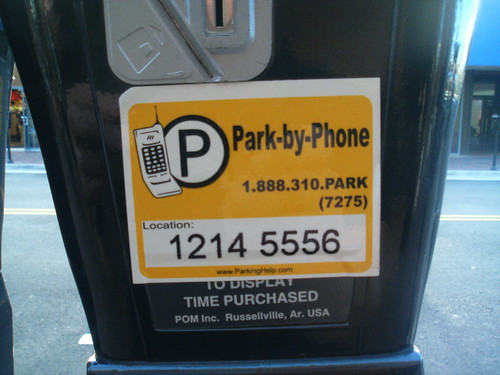More on mobile payments: NYTimes, Fandango (Crisp), PayPal, Katrina
 Lots to say, lots to say.
Lots to say, lots to say.
You may remember me bringing mobile payments up before. It's one of my central concerns where I'm doing some consulting, and we're specifically concerned about how the non-profit space is affected.
If you read the Times, you may have seen this headline today: "Group Questions Cellphone Fund-Raising."
The article is a quick read and details some interesting aspects of mobile giving, or mobile payments to charities. One of the best case studies in this is the "Text 2HELP" campaign, which was set up to allow people to SMS a $5 Hurricane Katrina gift.
While the Times article is all about the controversy around charging up to 15 cents per SMS-gift (what profiteering by the carriers!), it makes no mention of the fact that carrier facilitated transactions run with a 50% across the board, unless you're Bill Clinton and George H. W. Bush and can negotiate a lower tariff with the carriers.
What's left to the rest of the non-profits out there are services like PayPal's Text to Give, which is really just their mobile payments platform with a nice marketing campaign. They don't take any tariff, but you still have to sign-up for PayPal and authenticate your phone. It's not a tough process if you already have a PayPal account, but still it sets a barrier which is restrictive: after all, we're looking for people to GIVE IMPULSIVELY!
Back to Katrina, one interesting statistic is that only $100,000 was raised through their SMS campaign. At $5 a gift, that's only 20,000 people, and not very much money in general, considering all the media surrounding the catastrophe and the total raised from other sources.
Point being: stand alone mobile giving may be tough to convince people on, and there are tons of barriers if you want to take advantage of SMS (either the carriers steal 50% or your customers/givers must register their payment info before giving).
Yuk.
But this is just SMS. On the WAP side, there may be some light. I had the good fortune of talking with all the top guys at Crisp Wireless (proudly a NYC-based company). These guys power USA Today's mobile site, as well as several other magazines, and the transaction oriented wap.Fandango.com. If you read Google News' mobile offerings, many of the sites seem to be powered by these fine folks.
With mobile payment via WAP, payments work like any other web-based payment... Type in your credit card number, expiration information, and your ZIP-code and BAM! -- payment sent, thank you very much, enjoy your movie.
So what are the barriers to WAP? User penetration is low. Really, I think it boils down to data, knowhow, and trust. Using your phone for internet is foreign to many people and they don't have data packages (or even if allowed to use some data for free, they still remember when it was über-expensive). Wait, data IS über-expensive... I pay $50 a month extra for my unlimited data from Verizon. Un-cool.
The Crisp fellows did provide some interesting numbers on WAP usage (and other mobile usage for that matter). While 38% of mobile phone customers use SMS, "only" 12% use WAP. I use quotation marks because I thought that 38% was strikingly low for SMS, so 12% to SMS's 38% doesn't seem that bad to me.
Conclusions: I guess I take a few lessons out of all of this.
If you're looking to do a stand-alone mobile payment set-up, WAP payments might make the most sense unless your a former President and can remove the 50% tariff, or unless you're selling wall paper, ring-tones or premium (subscription) content and your margins start so high you don't have to worry about losing 50% of your revenue.
WAP feels just like the web payments you're used to, you don't have to sign-up for anything or remember a shortcode or SMS semantics (for PayPal, which I used today to send my brother $5, you have to type "send [dollar ammount] to [phone number]". Screw that up and you don't have a payment.)
The best option is probably not doing a stand alone payment system. What I mean by that is that mobile payments need to be integrated into a larger online presence, especially if you have a site which is membership based. If you are an online store or subscription-based site, for instance, and if your users store their payment information with you in their profile, then you can have them authorize payments via SMS or WAP and allow the payment to go through on the streamlined back-end, not the challenging front-end of the mobile web.
Also, with WAP and SMS having low penetration (again, sub-50%!), it will be the responsibility of those with an online presence already to move folks onto mobile platforms and mobile payment systems, as carriers and PayPal (VeriSign and Visa Mobile as well) can only do so much.
Finally, this is all assuming nothing changes with the way the carriers do business. Indeed the ball could be in their court on the subject of mobile payments, because if they set-up their own mobile payment option as a stand-alone service and turned the phone into a credit card, they could sign users up at the point of sale (POS) or any point along the way and really get into an interesting a lucrative business. I say stand-alone because the current set-up with SMS payments feels too much like how sketchy 900 numbers work (WTF is this charge on my bill!?).
Take home point: Phone bill must remain clean and consistant, and mobile payments must be as flexible as an AMEX. Meanwhile, carriers hold the key to this, but likely won't move very soon and consumers won't addapt too quickly, so your best best is extending your online presence to the "third screen" and streamlining payments on the back-end.